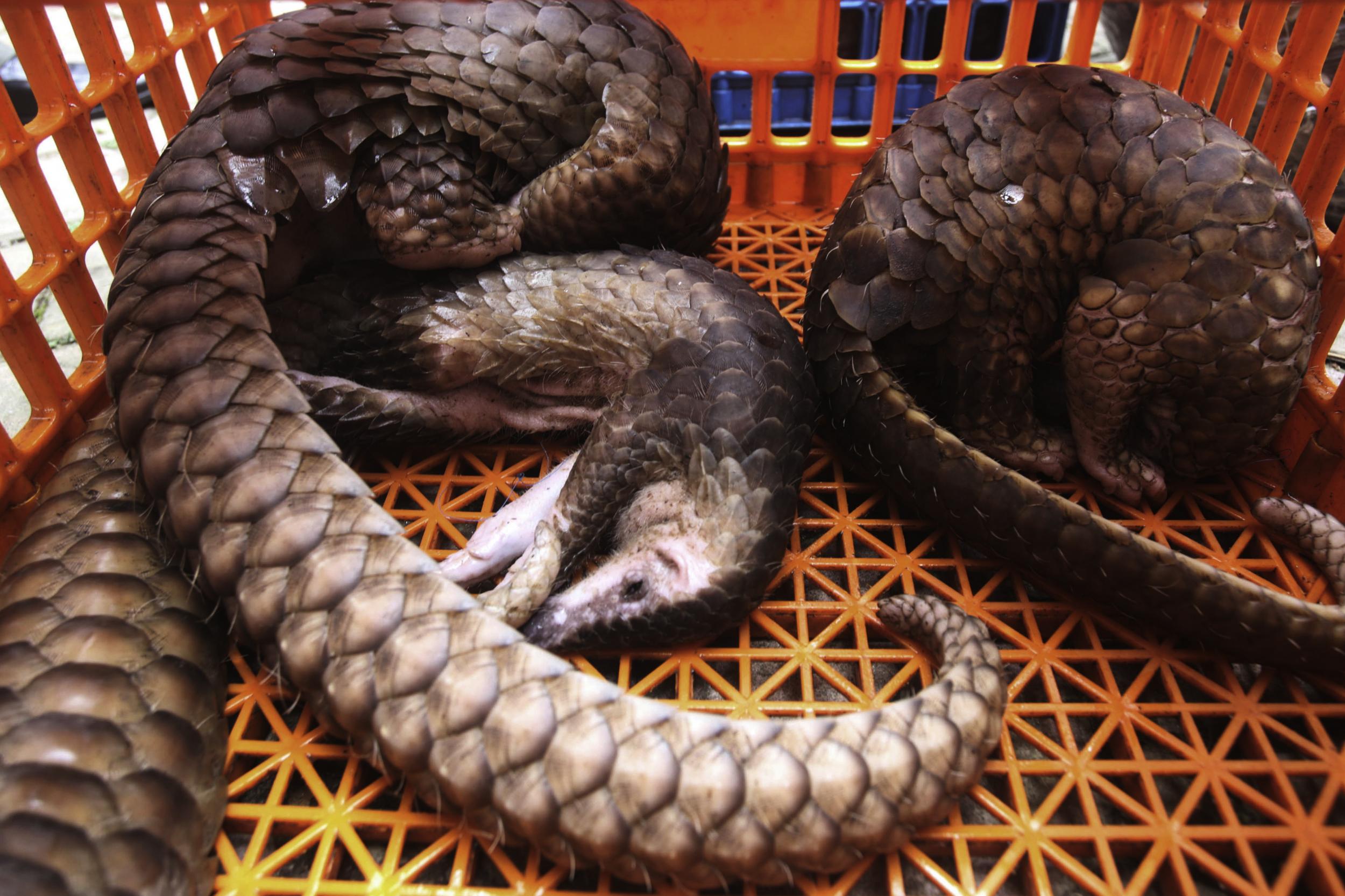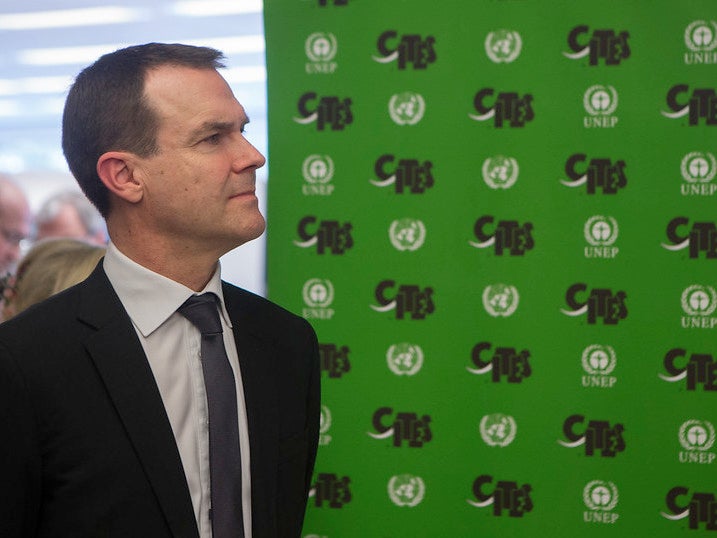Confront illegal wildlife trafficking with international criminal laws, former global trade chief says
John Scanlon was Secretary-General of the UN-affiliated Convention on International Trade in Endangered Species from 2010 until 2018

The former head of the global convention on international wildlife trade says that current rules surrounding legitimate enterprise “don’t cut it” to prevent future pandemics and that wildlife crime should be confronted with the same international legal force that tackles human trafficking and terrorism.
John Scanlon served as Secretary-General of the Secretariat overseeing the Convention on International Trade in Endangered Species of Wild Fauna and Flora (CITES) from 2010 until 2018.
CITES is affiliated with the United Nations Environment Programme and was established as a legally binding agreement to prevent the cross-border legal trade in wild animals and plants from threatening species survival.
The convention is a regulator, not a law enforcement agency to confront criminals or punish them. Currently, there is no global legal agreement on wildlife crime despite the enterprise being valued at $23bn (£18bn) a year and amounting to thousands of tonnes of contraband. It has provided a low-risk source of income for terrorist groups and criminal gangs.
Individual countries face this onslaught and in places, domestic legal systems have been found woefully underprepared for sophisticated traffickers. A study last year found that one in every five vertebrate species are traded as pets or to be used as products around the world, putting nearly 9,000 species at risk of extinction.
Mr Scanlon, who is now special envoy for conservation non-profit African Parks, said that in a post Covid-19 world, profound measures are needed to tackle the scale of illegal trade which drains government revenues along with impacting ecosystems and threatening public health.
"We now need to fully embed this in the international criminal justice framework,” he told The Independent.
He also suggested bolstering CITES to mitigate the risk of future pandemics.
CITES was adopted in 1973 to tackle the rampant exploitation of wildlife when countries had little recourse to protect their threatened species. Some 182 countries and the EU are currently signed up to the convention. It breaks down into three lists - appendices - each dealing with an increasing level of threat.
Appendix I bans commercial trade in species at threat from extinction such as gorillas, sea turtles and giant pandas. Appendix II controls trade in species being monitored for risk of extinction like the high-value timber, rosewood, and many corals. If a scientific finding concludes that the trade will not affect survival of the species and it has been legally obtained, it will be allowed to go ahead. Appendix III addresses species that are protected in at least one country and where that country has asked for help in monitoring the trade.
Mr Scanlon said: “I remain firmly of the view that CITES neither encourages or discourages trade. It's quite neutral on that. That's a sovereign decision of a state and if you choose to trade in species listed under the convention, you have to comply.”
Some 30,000 plants and 6,000 animals are protected under CITES - a vast array of wildlife but still a fraction of the world’s 8.7m species. Legal trade accounts for around one million transactions each year.
It's up to individual countries to tackle trafficking and poaching. In 2014, the law firm, DLA Piper, reviewed the illegal wildlife trade in eleven countries and found that a “host of weaknesses” existed in legislation to punish wildlife crime including inconsistencies in penalties and limited prosecutorial power.
“The only consistent theme in the country reports is that significant work needs to be done in every country in order to effectively tackle the illegal wildlife trade,” the firm noted.
CITES can enforce sanctions on countries who violate the convention, the most serious being a suspension in all wildlife trade. However because CITES is voluntary, a country could leave the convention rather than comply.
To better understand CITES, it helps to consider some other things that it's not. The convention is solely focused on wildlife which moves across international borders and not within countries or a bloc, like the EU.
Nor does the convention address human health, animal health or how invasive a species might be to a country. It doesn’t tackle wildlife markets or consumption.
“The parties wanted to keep the convention very narrowly focused on the issue of overexploitation, looking at trade from a biological perspective and if it will threaten the survival of the species,” Mr Scanlon said.
In that sense, CITES has had success: There is well-regulated trade in alligators, the US Fish and Wildlife Service reported, and vicunas, a relative of the llama. Under Mr Scanlon’s tenure, protections for a number of new marine species, including sharks and rays, along with timber species were added. The volume of species covered by CITES quadrupled from 1975 to 2014, according to one study.
However Mr Scanlon said that the pandemic has exposed gaps in CITES’ siloed approach. "CITES cannot just look at authorised trade on the basis of its threat to the species and not be troubled by public health or animal health risk. I don't think that can cut it in 2020," he said.
"With all the knowledge we have from scientists and public health officials, we've come to understand in a devastating way through the Covid-19 pandemic that we can't isolate these things."
Some animals known to have human health risks are not necessarily restricted under CITES. For example, horseshoe bats, hosts for a number of viruses, are not listed.
In remarks last month, Mr Scanlon pointed to pangolins to illustrate the convention's difficulty in tackling wildlife crime. Despite having the highest-level of protection, illegal trade in the “scaly ant-eaters” is at a record high. Pangolins have been suggested as a potential intermediary host of Covid-19 although research is so far inconclusive.
The coronavirus, which originated in Wuhan, China in late 2019, is believed to have jumped from an animal to human in a “zoonotic spillover” event. Scientists have suggested the virus was transmitted from a bat via an intermediary species.
The pandemic has been a devastating wake-up call to the human health risks from zoonotic diseases which can emerge in both the regulated, legal and illicit wildlife trade.
Mr Scanlon said that to confront all sides of the issue requires a new criminal framework and considering an expansion of CITES.
“On the illegal trade side, I’d say bite the bullet and embed that into the international criminal justice system,” he said.
Wildlife crime could come under the UN Convention against Transnational Organised Crime. It would be a fitting home for what has been estimated as the world’s fourth largest criminal enterprise after drugs, arms and human trafficking.
“If countries create an international framework that says wildlife crime is serious and needs to be dealt with by a criminal justice system, it sends a powerful message that filters down to the field,” Mr Scanlon said.
The UN’s organised crime convention has the tools to share information among states, a necessity for wildlife crime which flows across borders.
When it comes to taking more stringent measures in legal wildlife trade, CITES appears a logical choice because of its long-established framework, he said.
"There's not an appetite for creating a whole lot of new governance structures if you can avoid it,” Mr Scanlon noted.

In a souped-up version of its current state, CITES could include public health criteria for listing species and have authorities consider public health before allowing trade. This would fit with the World Health Organisation’s “One Health” approach which knits together human, animal, plant and environmental health in its decision-making.
Alternatively, a new agreement on wildlife trade could be added to the Conventional on Biological Diversity or with the World Health Organisation, as has been done to recognise the risks associated with tobacco.
Ultimately, it’s a decision that’s down to states but international cooperation is key to long-lasting change.
“It's too important an issue to leave to countries to deal with individually. One country might do great job but another doesn't and you're still exposed to the risk,” Mr Scanlon said.
“We have a whole framework for dealing with trade in species in terms of overexploitation. So surely having similar rules in place for dealing with potential future pandemics can be justified.”
When he took up the post of secretary-general in 2010, Mr Scanlon said the scale of the challenge was immediately apparent.
“We were confronting a surge in illegal trade in wildlife particularly in the African elephant for its ivory and in rhino horn,” he said.
Between 2010-2012, a staggering 100,000 African elephants were poached. In the absence of an alternative, Mr Scanlon established the International Consortium on Combating Wildlife Crime (ICCWC) pulling together Interpol, the United Nations Office on Drugs and Crime, the World Bank and the World Customs Organisation. The global effort also included the International Air Transport Association; the World Travel and Tourism Council, The International Fragrance Association and United For Wildlife, an initiative spearheaded by Prince William.
“There was a need to bring on board the agencies that deal with enforcement of organised crime,” Mr Scanlon said. “My view was everyone was welcome to participate."
Following the effort, poaching in African elephants fell for five consecutive years. In 2015, CITES and the World Animal Health Organisation (OIE) also signed an agreement to collaborate on protecting animals and safeguarding biodiversity. Yet plans to work together could not change the inherent limitations of the convention.
Mr Scanlon said: “I think it's important for those of us who know how the system works to offer a set of options and start stimulating some thinking. The status quo ought not be allowed to prevail.”
The Independent is calling for an end to the high-risk sale and illegal trafficking of wildlife with our campaign, Stop The Wildlife Trade
Join our commenting forum
Join thought-provoking conversations, follow other Independent readers and see their replies
Comments